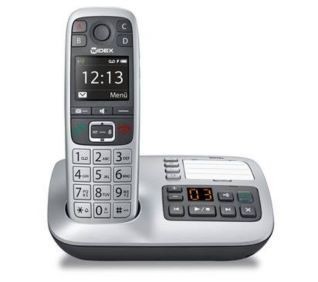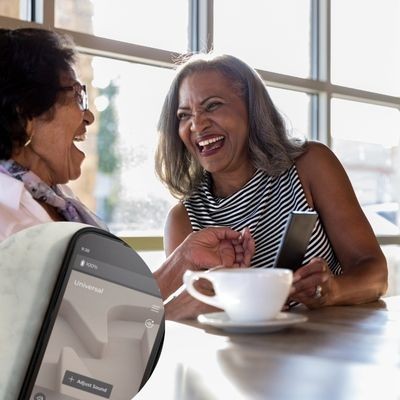Free home visits
with a local audiologist

Head of Online Medical Content

Audiology Expert at Hearing Aid UK

What are phones for the hard of hearing? | Examples of Phones for Hard of Hearing Mobiles | Best mobiles and best house phones | Consider your options | Signs to look out for
Phones for hard hearing are designed to help individuals who experience hearing loss, communicate over the phone more easily. The phones are designed with a wide variety of features to enhance things such as hearing aid compatibility, visual indicators, amplification and many more.
In this article, we will cover the characteristics and elements of hard for hearing phones and how they can benefit you depending on your unique hearing challenges. Continue reading to find out what hard of hearing phone best suits your needs, allowing you to be able to communicate with family and loved ones without any issues.
In today's market, there are various styles of phones for hard of hearing and the choice you make is often dictated by your specifications, like your level of hearing loss and even level of sight. They range from basic devices to premium phones that will cost you more but offer more features that will assist and improve your communication with loved ones.
Most hearing aids that we supply can also have a matching landline phone produced by the same manufacturer which will help to provide the most effective hearing possible for you on the phone.
Contact us if this is something you wish to discuss, or if you just want general information about phones then read below.
The phones for hard of hearing have come a long way and now they work very similar to hearing aids in regards to filtering unwanted background noise, so words are more clear. Modern hard of hearing phones cater to varying levels of losses and can really improve the quality of your communication and lifestyle.
However, if you have a more severe loss, you will probably need one that offers a larger dB volume so you can successfully communicate.
A great example of a cordless phone would be the Widex PHONE DEX - a telephone for the hard of hearing, as seen in the image below. This type of telephone is designed for people with hearing loss. You can pair it with your hearing aids or use it as a conventional phone as well.
While landline phones for hearing loss don't offer the freedom of smartphones, they do offer additional features like very loud ringers and lights that indicate an incoming call. Telephones for hard of hearing like this one, provide you with excellent speech understanding in both ears.

Here are a few more specifics to consider when choosing a cordless phone for hearing loss:
What is the Doro phone? We have a lot of queries about the best phones for hard of hearing and dexterity. We thought it might be beneficial to talk a little bit about the Doro mobile, as it is such a great example and patients have liked the simplicity of the technology.
The Doro phone is a user-friendly mobile phone that appeals to those who are hard of hearing, have trouble with dexterity, vision impairment and is ideal for the older generation who are active. They are designed and created with seniors in mind with a louder sound, large buttons, separated keys and digital hearing aid compatibility.
The Doro phone's main priority is to make life easier for the elder generation, giving them and the ones they love the peace of mind. However, they also appeal to all ages as they are great for those who have difficulty with sight. Bigger buttons also allow for a more simple solution for communicating.
These mobiles offer the Android smartphone experience combined with an easy-to-use interface, built-in assistance and extra security safety features.
They started off with a lack of the innovative features you’d get with today’s smartphone, like touchscreen displays and high-res cameras – but they are what they are and provide a device that is great for calls and texts for active seniors.
Now Doro offers simple smartphones that give consumers the best of both, so you can now benefit from some smartphone features in a user-friendly package – making Doro phones a popular simple mobile phone brand.
In today’s market, Doro phones can cost from around £25 to £180 – it all depends on what you want and what you need your mobile phone for. For instance, if you want to link hearing aids you might be limited on what model you can go for, as not all will be compatible with all hearing aids and - more importantly - the devices you are currently wearing.

| Doro 1370 mobile phone | Doro 730X mobile phone |
| Doro 7010 mobile phone | Doro 6040 mobile phone | Doro 1360 mobile phone |
| Doro 6824 mobile phone | Doro 7000H mobile phone | Doro 2404 mobile phone |
| Doro 6620 mobile phone | Doro 7080 mobile phone | Doro 5516 mobile phone |
| Doro 6060 mobile phone | Doro 780X mobile phone | Doro 5860 mobile phone |
| Doro 5860 mobile phone | Doro 6820 mobile phone | Doro 6880 mobile phone |
At the end of the day, like with a lot of technology, you have to way it all up. What do you want from your phone? What do you need it for? Do you find using modern smartphones difficult? It is important to remember that sometimes cheaper smartphones have numerous features that are tricky to use due to being a lower specifications option.
The best thing to do is visit a mobile phone store and have a look at their Doro phone options, as well as compare them to a cheaper smartphone alternative. Then ask a member of staff to go through some of the main features you’d use every day and see if the Doro phone is right for you.
Here are some more examples of the main phone brands that are ideal for those who are hard of hearing. They include some of the features of the Doro phone as well as powerful voice and ringer volume, big buttons and adjustable options.

If you are a hearing aid wearer and are thinking about purchasing a smartphone like the Doro mobile phone, speak to your audiologist as you’ll need to double-check check your hearing aids are compatible with said device. Or failing that, what hearing aids are compatible with each Doro model.
When looking for a phone for hard of hearing there are various specifics to consider. Here we look into what options are available and which might be better for you. To make it easier we have broken guidance into hearing loss levels.
If you have this level of hearing loss, which is usually age-related, you might not need to do anything in particular when using your mobile phone with your devices. Your hearing aid microphones will just pick up the sound from the phone. That being said, you are more than likely going to get some degree of background noise here.
If you have this kind of severe hearing loss and frequently use your mobile you would naturally desire clear speech and sound. We would recommend wearing hearing aids that include Bluetooth for that extra boost and a telecoil feature.
Hearing aids which include telecoil can direct sound to the device's processing technology without the need for a microphone. It also offers a much-improved signal-to-noise ratio, as well as reducing feedback.
From experience, many of our patients who have hearing loss and wear hearing aids opt to use their smartphones to communicate every day at home and on the go rather than purchasing a phone specifically for hard of hearing.
They connect and pair their iPhone or Android mobiles (as well as other wireless devices) to their hearing aids and stream calls, audio and much more via Bluetooth technology.
They can also manage their hearing aid devices by boosting their hearing in a challenging environment or adjusting settings and volume. They generally have a cordless phone for hard of hearing at home for landline calls. All modern hearing aids have Bluetooth and offer premium connectivity and connection to loved ones.
Phones have become invaluable tools for people with hearing loss. They offer features like telecoil compatibility, which directly connects to hearing aids for clearer sound. Amplified phones boost volume and reduce background noise, while visual caller ID and vibration alerts ensure no missed calls.
We are here to support you and your hearing healthcare and we can also put you in touch with your local audiologist who can then advise you on the best phones for hard of hearing in your consultation.
You can also call one of our experts free on 0800 567 7621 for any advice about hearing healthcare and hearing solutions. Alternatively, fill out the contact form further down the page and we will contact you as soon as we can.
 I Keep Turning Up the Volume on the TV – Do I Have Hearing Loss?
I Keep Turning Up the Volume on the TV – Do I Have Hearing Loss?  I have difficulty hearing in noisy places
I have difficulty hearing in noisy places  High-Pitched Sounds Like Birdsong Are Fading. Do I Have Hearing Loss?
High-Pitched Sounds Like Birdsong Are Fading. Do I Have Hearing Loss? Do not spend hundreds of pounds without getting a second opinion from us.
 Not only are the prices great, but the service is fantastic! Many thanks to your team.
Not only are the prices great, but the service is fantastic! Many thanks to your team.If you are looking at this page then it is likely that an audiologist has suggested that you purchase this particular hearing aid, so is this the best model for you?
In general, any audiologist will always recommend to you the model that best suits your needs. Here is a useful checklist to make sure that is the case.
If in doubt, feel free to give us a call. That's what we're here for. In the meantime, read all about our review of the best hearing aids for 2025 here
If you have significant hearing loss in both ears, you should be wearing two hearing aids. Here are the audiological reasons why:
Localisation: The brain decodes information from both ears and compares and contrasts them. By analysing the minuscule time delays as well as the difference in the loudness of each sound reaching the ears, the person is able to accurately locate a sound source. Simply put, if you have better hearing on one side than the other, you can't accurately tell what direction sounds are coming from.
Less amplification is required: A phenomenon known as “binaural summation” means that the hearing aids can be set at a lower and more natural volume setting than if you wore only one hearing aid.
Head shadow effect: High frequencies, the part of your hearing that gives clarity and meaning to speech sounds, cannot bend around your head. Only low frequencies can. Therefore if someone is talking on your unaided side you are likely to hear that they are speaking, but be unable to tell what they have said.
Noise reduction: The brain has its own built-in noise reduction which is only really effective when it is receiving information from both ears. If only one ear is aided, even with the best hearing aid in the world, it will be difficult for you to hear in background noise as your brain is trying to retain all of the sounds (including background noise) rather than filtering it out.
Sound quality: We are designed to hear in stereo. Only hearing from one side sounds a lot less natural to us.
Fancy some further reading on this topic? You can read about why two hearing aids are better than one in our article, hearing aids for both ears, here
For most people, the main benefit of a rechargeable hearing aid is simple convenience. We are used to plugging in our phones and other devices overnight for them to charge up. Here are some other pros and cons:
For anybody with poor dexterity or issues with their fingers, having a rechargeable aid makes a huge difference as normal hearing aid batteries are quite small and some people find them fiddly to change.
One downside is that if you forget to charge your hearing aid, then it is a problem that can't be instantly fixed. For most a 30-minute charge will get you at least two or three hours of hearing, but if you are the type of person who is likely to forget to plug them in regularly then you're probably better off with standard batteries.
Rechargeable aids are also a little bit bigger and are only available in Behind the Ear models.
Finally, just like with a mobile phone, the amount of charge you get on day one is not going to be the same as you get a few years down the line. Be sure to ask what the policy is with the manufacturer warranty when it comes to replacing the battery.
Looking for more information on rechargeable hearing aids? Read our dedicated page on the topic here
For most people, the answer is yes. But it's never that simple.
The majority of hearing problems affect the high frequencies a lot more than the low ones. Therefore open fitting hearing aids sound a lot more natural and ones that block your ears up can make your own voice sound like you are talking with your head in a bucket. Therefore in-ear aids tend to be less natural.
However the true answer is we can't tell until we have had a look in your ears to assess the size of your ear canal, and until we have tested your hearing to see which frequencies are being affected.
People with wider ear canals tend to have more flexibility, also there are open fitting modular CIC hearing aids now that do not block your ears.
There is also the age old rule to consider, that a hearing aid will not help you if it's sat in the drawer gathering dust. If the only hearing aid you would be happy wearing is one that people can't see, then that's what you should get.
Most people can adapt to any type of hearing aid, as long as they know what to expect. Have an honest conversation with your audiologist as to what your needs are.
Generally speaking, six or more. Unless it's none at all.
The number of channels a hearing aid has is often a simplistic way an audiologist will use to explain why one hearing aid is better than another, but channels are complex and it is really not that straightforward. Here are some reasons why:
Hearing aids amplify sounds of different frequencies by different amounts. Most people have lost more high frequencies than low and therefore need more amplification in the high frequencies. The range of sounds you hear are split into frequency bands or channels and the hearing aids are set to provide the right amount of hearing at each frequency level.
Less than six channels and this cannot be done with much accuracy, so six is the magic number. However, a six channel aid is typically very basic with few other features and is suitable only for hearing a single speaker in a quiet room. The number of channels is not what you should be looking at, it's more the rest of the technology that comes with them.
As a final note, different manufacturers have different approaches. One method is not necessarily better than any other. For example, some manufacturers have as many as 64 channels in their top aids. Most tend to have between 17 and 20. One manufacturer has no channels at all.
Hearing aids are easily lost, misplaced or damaged and typically are one of the most expensive personal possessions an individual can own. We offer hearing aid warranty coverage for £80 per year per aid. Find out more about this service we provide here
All our audiologists use the very latest technology and provide the full range of tests to accurately measure your hearing for free. Find out about what hearing healthcare services we offer all our customers here
Hearing Aid UK offers all their customers free home visiting services, even in a care home environment, for no extra cost. Including hearing tests, fittings, maintenance, check-ups and much more in the comfort of your own home and at your convenience. Find out more information about our home visits here
Here, at Hearing Aid UK, we are dedicated to offering low hearing aid prices. We achieve this by having no head office and low marketing costs. Our hearing aid prices are amongst the lowest you will find anywhere in the world. Explore our prices, brands, and models here
When we refer to a product as 'Latest Launch', we mean it is the latest to be released on the market.
When we refer to a product as 'New', we mean that the product is the newest hearing aid model on the market.
When we refer to a product as 'Superseded', we mean that there is a newer range available which replaces and improves on this product.
When we refer to a product as an 'Older Model', we mean that it is has been superseded by at least two more recent hearing aid ranges.